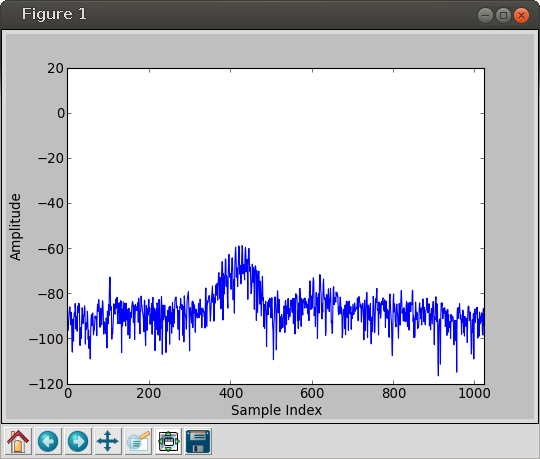Examples¶
These examples may be found in the “examples” directory included with the PyRF source code.
show_i_q.py¶
This example connects to a device specified on the command line, tunes it to a center frequency of 2.450 MHz then reads and displays one capture of 1024 i, q values.
#!/usr/bin/env python
import sys
from pyrf.devices.thinkrf import WSA4000
# connect to wsa
dut = WSA4000()
dut.connect(sys.argv[1])
# setup test conditions
dut.reset()
dut.request_read_perm()
dut.ifgain(0)
dut.freq(2450e6)
dut.gain('low')
dut.fshift(0)
dut.decimation(0)
# capture 1 packet
dut.capture(1024, 1)
# read until I get 1 data packet
while not dut.eof():
pkt = dut.read()
if pkt.is_data_packet():
break
# print I/Q data into i and q
for i, q in pkt.data:
print "%d,%d" % (i, q)
Example output (truncated):
0,-20
-8,-16
0,-24
-8,-12
0,-32
24,-24
32,-16
-12,-24
-20,0
12,-32
32,-4
0,12
-20,-16
-48,16
-12,12
0,-36
4,-12
plot_fft.py¶
This example connects to a device specified on the command line, tunes it to a center frequency of 2.450 MHz and sets a trigger for a signal with an amplitude of -70 dBm or greater between 2.400 MHz and 2.480 MHz.
When the trigger is satisfied the data is captured and rendered as a spectrum display using NumPy and matplotlib.
#!/usr/bin/env python
from pyrf.devices.thinkrf import WSA4000
from pyrf.config import TriggerSettings
from pyrf.util import read_data_and_context
from pyrf.numpy_util import compute_fft
import sys
import time
import math
from matplotlib.pyplot import plot, figure, axis, xlabel, ylabel, show
# connect to wsa
dut = WSA4000()
dut.connect(sys.argv[1])
# setup test conditions
dut.reset()
dut.request_read_perm()
dut.ifgain(0)
dut.freq(2450e6)
dut.gain('high')
dut.fshift(0)
dut.decimation(0)
trigger = TriggerSettings(
trigtype="LEVEL",
fstart=2400e6,
fstop=2480e6,
amplitude=-70)
dut.trigger(trigger)
# capture 1 packet
data, context = read_data_and_context(dut, 1024)
# compute the fft of the complex data
powdata = compute_fft(dut, data, context)
# setup my graph
fig = figure(1)
axis([0, 1024, -120, 20])
xlabel("Sample Index")
ylabel("Amplitude")
# plot something
plot(powdata, color='blue')
# show graph
show()

Example output of plot_fft.py
twisted_show_i_q.py¶
This is a Twisted version of the show_i_q.py example above.
#!/usr/bin/env python
import sys
from pyrf.devices.thinkrf import WSA4000
from pyrf.connectors.twisted_async import TwistedConnector
from twisted.internet import reactor, defer
import twisted.python.log
# connect to wsa
dut = WSA4000(connector=TwistedConnector(reactor))
@defer.inlineCallbacks
def show_i_q():
yield dut.connect(sys.argv[1])
# setup test conditions
yield dut.reset()
yield dut.request_read_perm()
yield dut.ifgain(0)
yield dut.freq(2450e6)
yield dut.gain('low')
yield dut.fshift(0)
yield dut.decimation(0)
dut.connector.vrt_callback = receive_vrt
# capture 1 packet
yield dut.capture(1024, 1)
def receive_vrt(packet):
# read until I get 1 data packet
if not packet.is_data_packet():
return
# print I/Q data into i and q
for i, q in packet.data:
print "%d,%d" % (i, q)
# exit
reactor.stop()
d = show_i_q()
d.addErrback(twisted.python.log.err)
reactor.run()